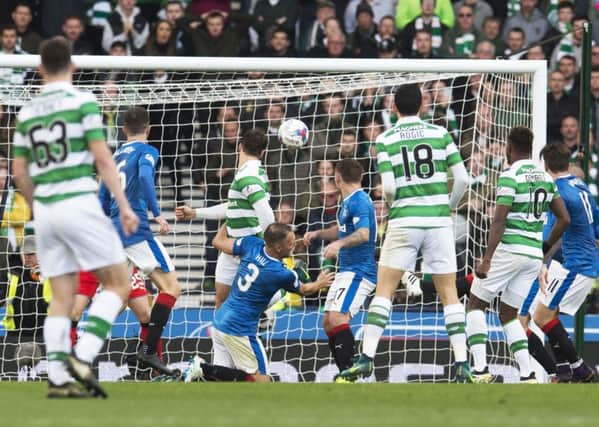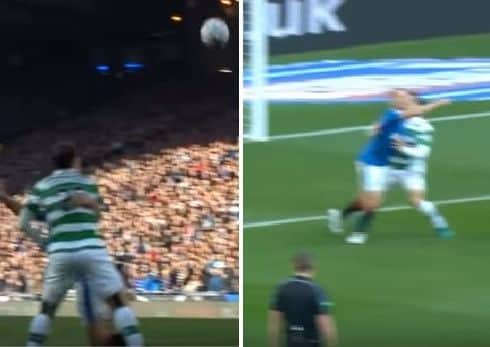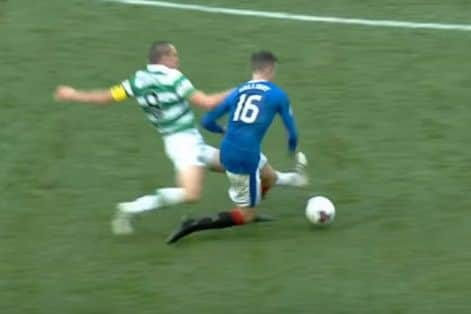Judging the referee's performance in Rangers 0 - 1 Celtic
This article contains affiliate links. We may earn a small commission on items purchased through this article, but that does not affect our editorial judgement.


The first contentious decision centred around Barrie McKay, who was booked for going to ground following a challenge inside the area from Jozo Simunovic. It’s definitely not a penalty. Simunovic is coming in at an angle which allows him to get clean contact on the ball before McKay makes contact with him on the follow through.
Advertisement
Hide AdAdvertisement
Hide AdThomson was criticised for the decision to book McKay for simulation. It is harsh, but there are reasons why Thomson came to this conclusion. The player throws an unnatural body shape as he goes to ground. He bends both of his legs and one of his hands in the air as he hurdles the challenge (Picture One). It’s the sort of thing which looks bad from a referee’s point of view, and it’s likely McKay was anticipating contact as he ran at the Celtic defender.


That being said, there is contact and McKay doesn’t begin his fall until after that contact is made. In this instance the player probably deserves the benefit of the doubt.
The moment that would later have Celtic fans spitting feathers came just four minutes into the second half. Erik Sviatchenko appeared to have given Celtic the lead, only for the goal to be disallowed for a foul on Clint Hill.
Prior to the “goal”, Sviatchenko is standing alone waiting for the cross and Hill sprints over to get touch tight. The Celtic defender feels his opponent coming and the two engage each other at the same time. Sviatchenko uses Hill’s momentum against him, and the Rangers centre-back exaggerates the contact as he goes to ground.
It all comes down to the angle of the referee. You can see the difference in Picture Two. The left looks like Hill is fouling Sviatchenko, the right looks the other way around. Crucially, the image on the right is Thomson’s angle. He can see the hand on the back from Sviatchenko. He can also see the Dane’s left-hand coming around to the torso of Hill as the Celtic defender looks to keep his balance while Hill loses his. He cannot see Hill’s arm on the back of Sviatchenko, so the contest does not look like “six and two-threes” to the referee.


They were both holding each other and these type of incidents are typically unpunished as they’re very minor. However, you can’t definitively call it a “wrong” decision because it was a foul in the very strictest interpretation of the rules. They state a free-kick should be awarded if a player “holds an opponent”. We all know that these things are not often given, but there is a certain justification for Thomson’s decision.
Something which hasn’t been made a lot of, which is surprising given the hysteria that follows every Old Firm game, is Scott Brown’s challenge on Andy Halliday. It was a frustrated tackle, coming less than 30 seconds after Celtic were appealing for a penalty for a (clean) challenge by Lee Wallace on Scott Sinclair. It’s the type of tackle from behind you don’t see very often these days because they’re so strictly enforced. Brown goes right through his man, leaves the ground in doing so (Picture Three) and takes Halliday down in a scissor motion.
Thomson shows a yellow card, which in the spirit of the game was the right decision, but Brown got a little lucky. It was a good natured Old Firm derby, with two of the four bookings for daft things like kicking the ball away and celebrating with fans. Had it been played under a more aggressive atmosphere, Brown may have walked.
Advertisement
Hide AdAdvertisement
Hide AdReferees often talk to each other about “orange cards” - challenges that fall somewhere between a yellow and a red - and this definitely falls into that category. Another aspect that helped Brown’s case was Halliday shifting the ball away from the Celtic captain just before he went to ground, making it look worse than it was.


Overall, Thomson had a decent match. He let play flow and didn’t dish out yellow cards too readily. Far too much has been made of the Sviatchenko disallowed goal, despite one TV replay clearly showing the referee’s angle, which happens to be the same one where the Celtic centre-back looks most guilty. Sometimes it feels like there needs to be controversy created out of nothing, instead of just concentrating on the football.
SEE ALSO
DOWNLOAD THE SCOTSMAN APP ON ITUNES OR GOOGLE PLAY